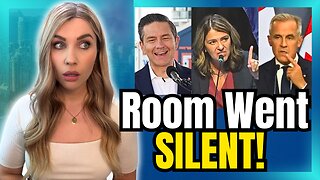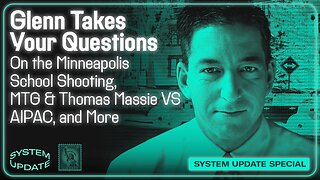Premium Only Content

Hitler's Speech in Lustgarten, Berlin – Day of National Labor, May 1, 1933
Background Leading Up to Hitler's Speech on the Day of National Labor
Hitler's Ascendancy: Adolf Hitler had been appointed Chancellor of Germany on January 30, 1933. By May 1933, he was consolidating his power, transforming Germany’s political landscape, and establishing the foundations of the Nazi regime.
The Reichstag Fire: The Reichstag Fire in February 1933 led to the Reichstag Fire Decree, which suspended civil liberties and allowed for the arrest of political opponents, significantly weakening the opposition.
Enabling Act: In March 1933, the Enabling Act was passed, giving Hitler and his cabinet the power to enact laws without the involvement of the Reichstag. This effectively marked the end of parliamentary democracy in Germany and solidified Hitler's dictatorial powers.
Labor Day Nationalization: May 1st, traditionally celebrated as International Workers’ Day by socialists and communists, was declared the "Day of National Labor" by the Nazi regime. This rebranding aimed to align the working class with the Nazi ideology and to co-opt labor movements under state control.
Dissolution of Trade Unions: The day after this speech, on May 2, 1933, the Nazis dismantled trade unions and replaced them with the German Labor Front (DAF), which brought workers under strict state control and aligned labor organizations with Nazi interests.
Hitler's Speech in Lustgarten, Berlin – Day of National Labor, May 1, 1933
On May 1, 1933, Adolf Hitler delivered a significant speech in Lustgarten, Berlin, on the Day of National Labor. This speech was part of the broader effort to integrate the working class into the Nazi state and to align labor interests with the goals of the regime.
Key Points of Hitler's Speech:
Celebration of German Workers: Hitler began by praising the German workers, highlighting their importance to the nation’s prosperity and strength. He acknowledged their contributions to rebuilding Germany and emphasized their role in the Nazi vision of a rejuvenated nation.
National Unity: A central theme of the speech was national unity. Hitler called for the unification of all Germans, transcending class divisions. He portrayed the Nazi movement as a force that would bring together all segments of society for the common good.
Critique of Class Struggle: Hitler condemned the concept of class struggle, which was central to Marxist ideology. He argued that class divisions were harmful to national unity and prosperity. Instead, he promoted a vision of a classless national community, where all Germans would work together harmoniously.
Workers' Rights and Duties: Hitler spoke about the rights and duties of workers. He promised improved working conditions, fair wages, and social security, asserting that the Nazi regime would protect and uplift the working class. However, he also emphasized that workers had duties to the nation, including loyalty and hard work.
Economic Revival: He discussed plans for economic revival, including reducing unemployment and revitalizing industry. Hitler assured the workers that the Nazi government was committed to creating jobs and improving their economic well-being.
Rejection of Communism and Socialism: The speech included a strong denunciation of communism and socialism. Hitler blamed these ideologies for Germany’s past troubles and positioned the Nazi Party as the true defender of workers’ interests against these divisive and destructive forces.
Nationalist Appeal: Hitler’s speech was infused with nationalist rhetoric. He called for a revival of German pride and patriotism, urging workers to see themselves as part of a larger national community dedicated to the greatness of Germany.
Analysis:
Hitler’s speech on May 1, 1933, was a strategic effort to co-opt the labor movement and integrate the working class into the Nazi state. By addressing workers directly and promising to improve their conditions, he aimed to win their loyalty and support for the regime.
Alignment with Workers' Interests: By praising workers and promising better conditions, Hitler sought to align the interests of the working class with those of the Nazi Party. This approach was intended to undermine socialist and communist influence among workers.
Emphasis on National Unity: The call for national unity and the rejection of class struggle were central to Nazi ideology. Hitler aimed to create a sense of common purpose and to dissolve class divisions that could threaten the regime’s stability.
Anti-Communist and Anti-Socialist Rhetoric: By condemning communism and socialism, Hitler positioned the Nazi Party as the true representative of workers' interests. This tactic aimed to erode support for leftist parties and to consolidate the working class under Nazi control.
Promise of Economic Revival: The focus on economic revival and job creation was designed to address immediate concerns of workers affected by the Great Depression. By promising economic improvement, Hitler aimed to gain their support for the regime’s broader goals.
Nationalist and Patriotic Appeal: The nationalist and patriotic elements of the speech were meant to foster a sense of pride and belonging among workers. By appealing to their patriotism, Hitler sought to integrate them into the national community envisioned by the Nazi state.
Overall, Hitler’s speech in Lustgarten, Berlin, on May 1, 1933, was a calculated effort to win the support of the working class and to integrate them into the Nazi regime. By promising better conditions, emphasizing national unity, and denouncing class struggle, Hitler aimed to position the Nazi Party as the true defender of workers' interests and to solidify his control over German society. This speech was a key moment in the regime's efforts to align all aspects of society with its ideological and political goals.
-
 LIVE
LIVE
Barry Cunningham
2 hours agoBREAKING NEWS: PRESIDENT TRUMP THIS INSANITY MUST END NOW!
12,092 watching -
 LIVE
LIVE
StevieTLIVE
1 hour agoWednesday Warzone Solo HYPE #1 Mullet on Rumble
95 watching -
 LIVE
LIVE
Geeks + Gamers
1 hour agoGeeks+Gamers Play- MARIO KART WORLD
103 watching -
 25:12
25:12
Jasmin Laine
6 hours agoDanielle Smith’s EPIC Mic Drop Fact Check Leaves Crowd FROZEN—Poilievre FINISHES the Job
57112 -
 1:13:28
1:13:28
Glenn Greenwald
3 hours agoGlenn Takes Your Questions on the Minneapolis School Shooting, MTG & Thomas Massie VS AIPAC, and More | SYSTEM UPDATE #506
81.7K28 -
 LIVE
LIVE
RCAM
10 minutes agoLIVE | Trans Shooter Who Targeted Christians | Premium Creator
16 watching -
 LIVE
LIVE
Spartan
4 hours agoMaybe finishing Expedition 33, then back to Halo Grind
8 watching -
 LIVE
LIVE
Armadillofather
2 hours agoEspionage Action in the Den! | Metal Gear Solid Delta | You being here means so much!
87 watching -
 11:14
11:14
China Uncensored
7 hours agoThis Is NOT What China Wanted To Happen
1.19K5 -
 LIVE
LIVE
ABD
2 hours agoCyberpunk 2077 | EP 2 - The Opening Act Pt.2 | 4K UHD
46 watching